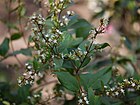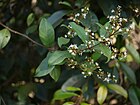Note: This is a project under development. The articles on this wiki are just being initiated and broadly incomplete. You can Help creating new pages.
Difference between revisions of "Ichnocarpus frutescens - Black creeper"
(→Commonly seen growing in areas) |
|||
| Line 54: | Line 54: | ||
==Commonly seen growing in areas== | ==Commonly seen growing in areas== | ||
| − | {{Commonly seen|Moist and Dry deciduous forests}, {{Commonly seen|In the plains | + | {{Commonly seen|Moist and Dry deciduous forests}}, {{Commonly seen|In the plains}}. |
==Photo Gallery== | ==Photo Gallery== | ||
Revision as of 08:09, 3 September 2023
Ichnocarpus frutescens is an much branched, Extensively twining shrub.
Contents
- 1 Uses
- 2 Parts Used
- 3 Chemical Composition
- 4 Common names
- 5 Properties
- 6 Habit
- 7 Identification
- 8 List of Ayurvedic medicine in which the herb is used
- 9 Where to get the saplings
- 10 Mode of Propagation
- 11 How to plant/cultivate
- 12 Commonly seen growing in areas
- 13 Photo Gallery
- 14 References
- 15 External Links
Uses
Fever, Stomachache, Wounds, Vomit, To Improve Breast Milk[1].
Parts Used
Chemical Composition
It contains the Various chemical category viz. Phytosterol, Triterpenes, Flavonoids and Various other phenolic compounds.[3]
Common names
| Language | Common name |
|---|---|
| Kannada | ಗೌರಿಬಳ್ಳಿ Gauriballi, ಹಾಲುಗೆಣಸು Halugenasu |
| Hindi | Bakkar bel, Dhimar bel |
| Malayalam | Nannari, Palvalli |
| Tamil | Utar-koti |
| Telugu | Korampala, Manitivva |
| Marathi | Kate bhowari, krishna sariva |
| Gujarathi | Shyamlata |
| Punjabi | NA |
| Kashmiri | NA |
| Sanskrit | Krishnasariva |
| English | Black creeper |
Properties
Reference: Dravya - Substance, Rasa - Taste, Guna - Qualities, Veerya - Potency, Vipaka - Post-digesion effect, Karma - Pharmacological activity, Prabhava - Therepeutics.
Dravya
Rasa
Guna
Veerya
Vipaka
Karma
Prabhava
Habit
Identification
Leaf
| Kind | Shape | Feature |
|---|---|---|
| Elliptic-Oblong | Ovate | Acute-Acuminate |
Flower
| Type | Size | Color and composition | Stamen | More information |
|---|---|---|---|---|
| Small | Greenish white | Scented in leafy cymose panicles. Flowering season is August-September |
Fruit
| Type | Size | Mass | Appearance | Seeds | More information |
|---|---|---|---|---|---|
| Fruiting season is August-September |
Other features
List of Ayurvedic medicine in which the herb is used
Where to get the saplings
Mode of Propagation
[[:Category:Index of Plants which can be propagated by |]]
How to plant/cultivate
Commonly seen growing in areas
Moist and Dry deciduous forests, In the plains.
Photo Gallery
References
- ↑ Indian Medicinal Plants by C.P.Khare
- ↑ ”Karnataka Medicinal Plants Volume-3” by Dr.M. R. Gurudeva, Page No.259, Published by Divyachandra Prakashana, #6/7, Kaalika Soudha, Balepete cross, Bengaluru
- ↑ [Chemistry]
- ↑ Common name
- ↑ Kappatagudda - A Repertoire of Medicianal Plants of Gadag by Yashpal Kshirasagar and Sonal Vrishni, Page No. 227
- ↑ [Cultivation]
External Links
Categories:
- Ayurvedic Herbs known to be helpful to treat Fever
- Ayurvedic Herbs known to be helpful to treat Stomachache
- Ayurvedic Herbs known to be helpful to treat Wounds
- Ayurvedic Herbs known to be helpful to treat Vomit
- Ayurvedic Herbs known to be helpful to treat To Improve Breast Milk
- Herbs with Root used in medicine
- Herbs with Leaf used in medicine
- Herbs with common name in Kannada
- Herbs with common name in Hindi
- Herbs with common name in Malayalam
- Herbs with common name in Tamil
- Herbs with common name in Telugu
- Herbs with common name in Marathi
- Herbs with common name in Gujarathi
- Herbs with common name in Sanskrit
- Herbs with common name in English
- Habit - Climber
- Index of Plants which can be propagated by
- Herbs that are commonly seen in the region of Moist and Dry deciduous forests
- Herbs that are commonly seen in the region of In the plains
- Herbs
- Pages without herbs images




